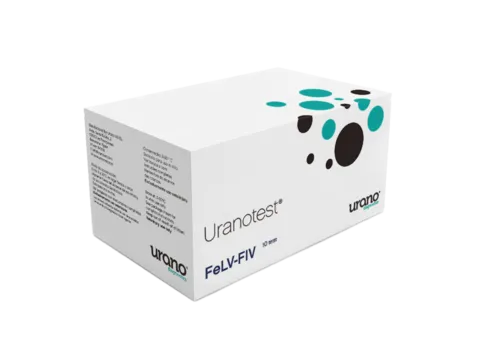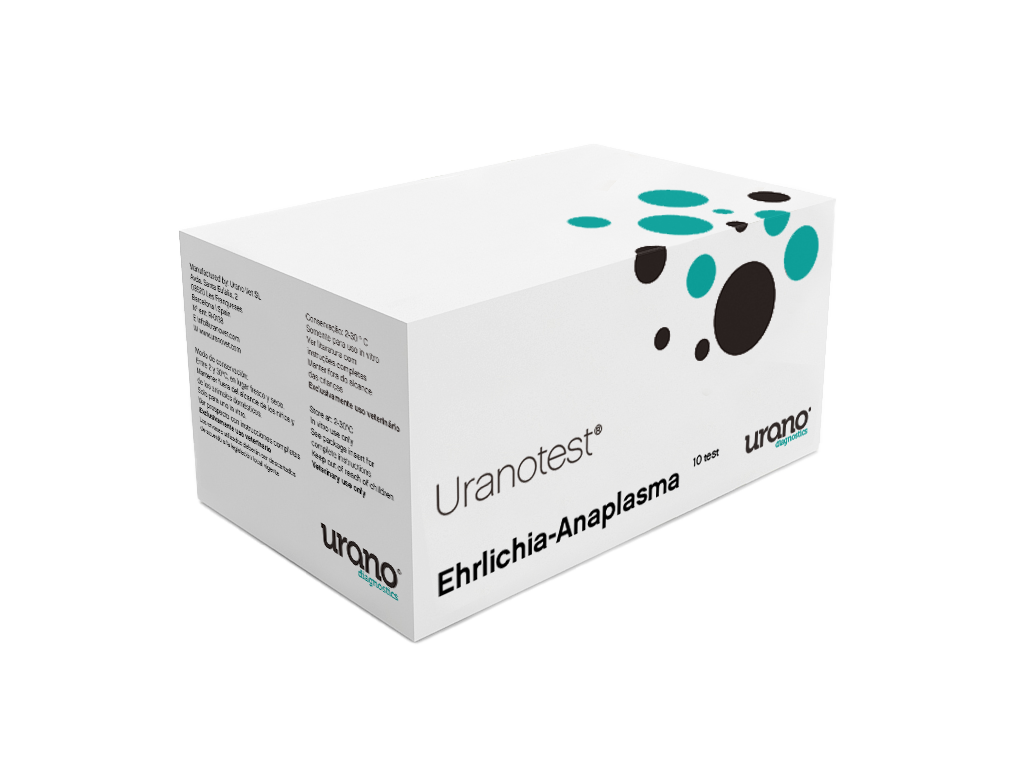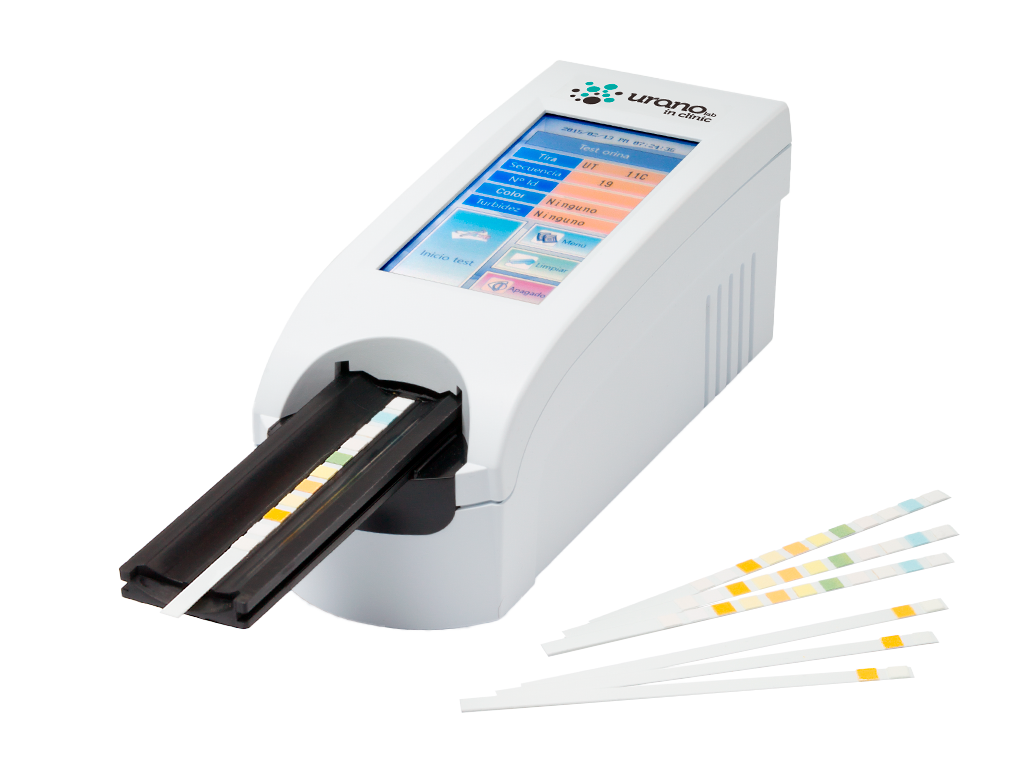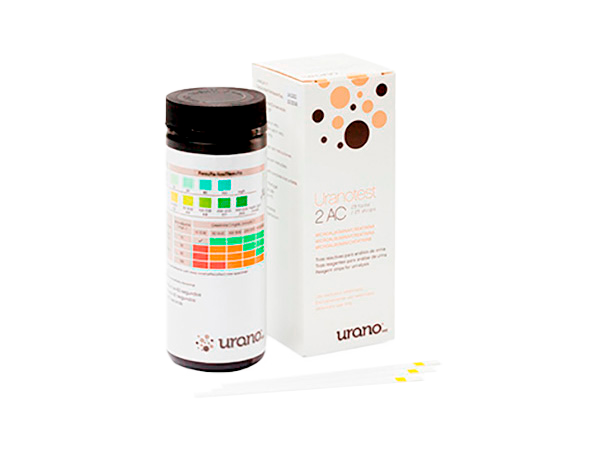
Diagnostic tests
Uranotest® FeLV-FIV
Simultaneous detection of feline leukaemia antigens and feline immunodeficiency antibodies in blood, serum or plasma.
Test available for reading in the Uranotest® Smart Reader app.
Specs
- Purpose
Simultaneous detection of Feline Leukaemia (FeLV) antigens and Feline Immune Deficiency antibodies (FIV)
- Sample
Whole blood, serum, plasma
- Sensitivity
- FeLV 94 % versus viral isolation
- FIV 96 % versus Western Blot
- Specificity
- FeLV 99 % versus viral isolation
- FIV 98 % versus Western Blot
- Execution time
2 minutes
- Reading time
5-10 minutes
- Presentation
Boxes of 5, 10 tests, and 30 tests
*Includes EDTA tubes for blood collection
Characteristics
- Ideal both for screening and for clinical differentiation in cats with clinical pictures compatible with both diseases.
- It detects specific p27 antigens (Leukaemia) and specific anti-gp40 antibodies (Immunodeficiency).
- It does not interfere with vaccinations.
- 2-step technique: savings in time and fewer errors.
Information for the veterinarian
The Uranotest® FeLV-FIV diagnostic kit is based on the immunochromatographic technique and is designed for the qualitative detection of Feline Immunodeficiency virus (FIV) and Feline Leukaemia virus (FeLV) in feline whole blood, serum and plasma.
The test has a double structure; it contains two single tests: a strip for FeLV antigen detection and a strip for FIV antibody detection. Each test consists of several overlapped membranes. On one of the membranes, there are a test line (T line) and control line (C line). The lines are not visible before applying the sample. After applying the sample in the appropriate sample well, migration begins by capillarity action through the membrane. If the result is negative, one purple colour band appears in the C area. This line, called control line, always appears, as it is a control line indicating that the test has successfully performed. If the test result is positive, in addition to the control line, a second line will form in the test area (Test line).
- Double test devices individually packaged in aluminium pouch.
- Dropper bottle with buffer solution.
- Disposable capillary pipettes for sample collection. The mark at the capillary indicates a volume of 10 µl.
- Vials with anticoagulant (EDTA) for blood collection.
- Instructions for use.
- For veterinary use only.
- Wear disposable gloves when handling the samples. All samples should be treated as potentially infectious. Wash and disinfect hands after handling. Avoid aerosol formation when dispensing the sample.
- To obtain good results, it is important to add the correct sample volume.
- Open the device just before use.
- All reagents must be at room temperature before performing the test.
- Do not use the test if the envelope is damaged or broken.
- Do not re-use.
- Do not use reagents after the expiry date.
- Do not use kits with different batch numbers.
- The quality of each component of the kit has been individually assessed for each batch. Do not mix components or reagents from kits with different batch numbers.
Frequently Asked Questions
The qualitative detection of the Feline Leukaemia virus (FeLV) antigen and the Feline Immune Deficiency virus antibody in serum, plasma or whole blood in cats.
Reliability is comparable when you use any of them.
However, when we work with very hemolysed or lipemic blood, it is always preferable to use serum or plasma, since hemolysis and lipemia are factors that interfere with any diagnostic technique, both at the clinic and at the Laboratory.
No, it is important to use a 10 micro-litre drop of sample, which can only be done with the aid of the disposable precision microcapillary supplied in the kit.
Administering a drop with a volume other than recommended may lead to an erroneous result.
Yes. You may use any other tube with anticoagulant treated with heparin, citrate or EDTA or with anticoagulant, if what you wish to do is use serum as a sample. The kit includes tubes with EDTA for your greater comfort and savings, but you may use any other one.
You should proceed as if it were for any other laboratory procedure.
The whole blood must be kept refrigerated at between 2ºC and 8ºC for no more than 24 hours. It should never be frozen.
If you are not going to be able to use it before 24 hours, separate the plasma by centrifugation or the serum by sedimentation, and you may keep it at between 2ºC and 8ºC for up to 72 hours. To preserve it for longer, freezing is recommended.
No, as with any other diagnostic procedure, you must wait until it reaches room temperature. If want to speed this process up, hold the tube between your hands for at least 20 minutes. Many veterinarians do not take this circumstance into account, and incorrect temperature is one of the most frequent causes behind false results.
After that time, degradation and diffusion of the colours on the strip may occur. This does not happen with all tests, but the recommendation is that the test should always be repeated if the reading was not taken before the indicated time, since this may lead to an erroneous interpretation.
Performing a test before putting a cat in the home is mandatory, especially for those coming from an environment without sufficient health guarantees, and periodically, for cats that have easy outside access and frequently escape.
The FeLV-FIV Uranotest® has a sensitivity and specificity very close to gold standards (laboratory reference technique) and can detect FeLV-FIV or FIV antibodies early on.
However, performing a test does not exclude pathogenesis of both illnesses, and the different phases of the infection must be taken into account: transitory viremia, persistent viremia or latent infection.
If the cat is in an initial infection stage, FeLV antigens or FIV antibodies are not detected. If we want to completely eliminate the risk of putting sick animals into the home, another test must be performed 90 days after the first one.
No, the Uranotest® detects the p27 antigen for the Feline leukaemia virus, which is not normally used for commercial vaccines currently in existence.
Yes, kittens may be checked at any age, taking the following factors into account:
In the case of FeLV, there is trans-placenta transmission and through the milk. As such, kittens from positive mothers may also be positive at birth and test negatively later on.
In the case of FIV, up to 12 weeks of life may have passive immunity from an infected mother and give a positive test. However, the virus is transmitted to the litter on only 30% of occasions. If a test is again performed 8-12 weeks later and the result is negative, it is highly improbably that the kitten is infected. On the other hand, if it is positive, we can determine that it is suffering from the infection.
The test is the first indispensable step in the diagnostic protocol for Feline leukaemia. A positive for FeLV shows the presence of the viral antigen in the blood, but is not a definitive diagnostic for leukaemia, lymphosarcoma or other illnesses associated with Feline leukaemia. As with any other laboratory procedure, the result must be evaluated along with other clinical and laboratory findings (blood work and other biochemical profiles).
It must be taken into account that cats with transitory viremia may become negative at 4-6 weeks.
A negative to FeLV shows the absence of the viral antigen in the blood at the exact time when it was performed.
This does not exclude infections in an early phase or neutralisation of the infection. For cats that have contacted other infected parties, it is recommended to repeat the test within 8-12 weeks.
The test is the first indispensable step in the diagnostic protocol for Feline immunodeficiency. A positive for FIV shows the presence of the viral antigen in blood, but this is not a definitive diagnostic until it is evaluated along with other clinical and laboratory findings.
It must be taken into account that cats with transitory viremia can become negative at 4-6 weeks.
A negative for FIV shows a lack of viral antigens in blood at the exact time when it was performed.
In initial phases of infection, no antibodies against FIV are produced. This is why for cats that have had contact with other infected cats, it is recommended to repeat the test within 12 weeks to totally exclude the risk of transmission. Also described is the fact that in the acute phase of the illness, the cat may not have antibodies in circulating blood.
Given the unspecific nature of symptomatology of leukaemia and feline immunodeficiency and the high prevalence, it is advisable to discard its presence by carrying out a test for any unspecific symptomatology pathology process. This is especially advisable for cats with clinical symptoms of oral disease, given the high correlation between oral pathologies and infection by feline retrovirus.

Uranotest® FeLV-FIV



